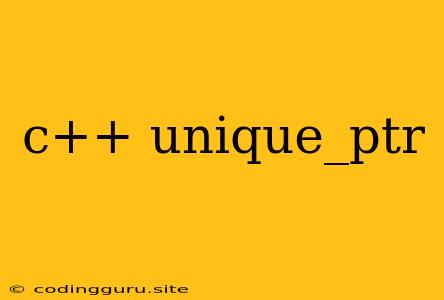Mastering Ownership in C++ with unique_ptr
C++ is renowned for its powerful features, but managing memory effectively can be a challenge. This is where unique_ptr comes into play, offering a safe and convenient way to handle object ownership in your C++ applications.
What is a unique_ptr?
In essence, unique_ptr is a smart pointer, a powerful tool designed to ensure that only one unique_ptr can point to a given object at any time. This single ownership guarantee eliminates the risk of dangling pointers and double-free errors, both notorious sources of memory leaks and crashes in C++.
Why Use unique_ptr?
The unique_ptr offers numerous benefits:
- Ownership Enforcement:
unique_ptrensures that only one pointer can own the object, preventing memory access violations and undefined behavior. - Automatic Resource Management:
unique_ptrautomatically manages the lifetime of the object it owns. When theunique_ptrgoes out of scope, the object is automatically deleted, ensuring proper resource cleanup. - Preventing Memory Leaks: By managing the lifetime of objects,
unique_ptreffectively prevents memory leaks, enhancing your code's stability and reliability. - Improved Code Clarity:
unique_ptrmakes your code more readable and maintainable by clearly indicating object ownership, simplifying memory management logic.
Using unique_ptr
Let's illustrate how unique_ptr works with a simple example:
#include
#include
class MyObject {
public:
MyObject() {
std::cout << "MyObject constructed!" << std::endl;
}
~MyObject() {
std::cout << "MyObject destructed!" << std::endl;
}
};
int main() {
// Create a unique_ptr on the heap
std::unique_ptr myObjectPtr(new MyObject);
// Access the object through the unique_ptr
std::cout << "Object is alive!" << std::endl;
// The unique_ptr automatically deletes the object when it goes out of scope
return 0;
}
Output:
MyObject constructed!
Object is alive!
MyObject destructed!
In this example, the unique_ptr named myObjectPtr holds ownership of the MyObject created on the heap. When myObjectPtr goes out of scope (at the end of main), the MyObject is automatically destroyed.
Key Features of unique_ptr
-
Move Semantics:
unique_ptrrelies heavily on move semantics. You can transfer ownership from oneunique_ptrto another using thestd::move()function. This avoids unnecessary copies and maintains the single ownership guarantee. -
Custom Deleters: You can customize how objects owned by
unique_ptrare deleted using custom deleters. This gives you fine-grained control over resource management. -
reset()Method: Thereset()method allows you to release the ownership of the object, potentially assigning a new object to theunique_ptrwithout affecting the original object's lifetime.
Best Practices for unique_ptr
- Avoid Raw Pointers: Strive to use
unique_ptras much as possible to manage dynamically allocated objects. - Use
std::move()for Ownership Transfers: When transferring ownership from oneunique_ptrto another, usestd::move()to ensure proper transfer without copying the object. - Consider Custom Deleters: If your objects have specific cleanup needs, consider using custom deleters to manage their resources effectively.
Conclusion
unique_ptr is an essential tool for modern C++ programming. By enforcing ownership, managing resources automatically, and preventing memory leaks, unique_ptr promotes safer, more reliable, and maintainable code. Embrace unique_ptr in your C++ projects and unlock the benefits of robust memory management!
